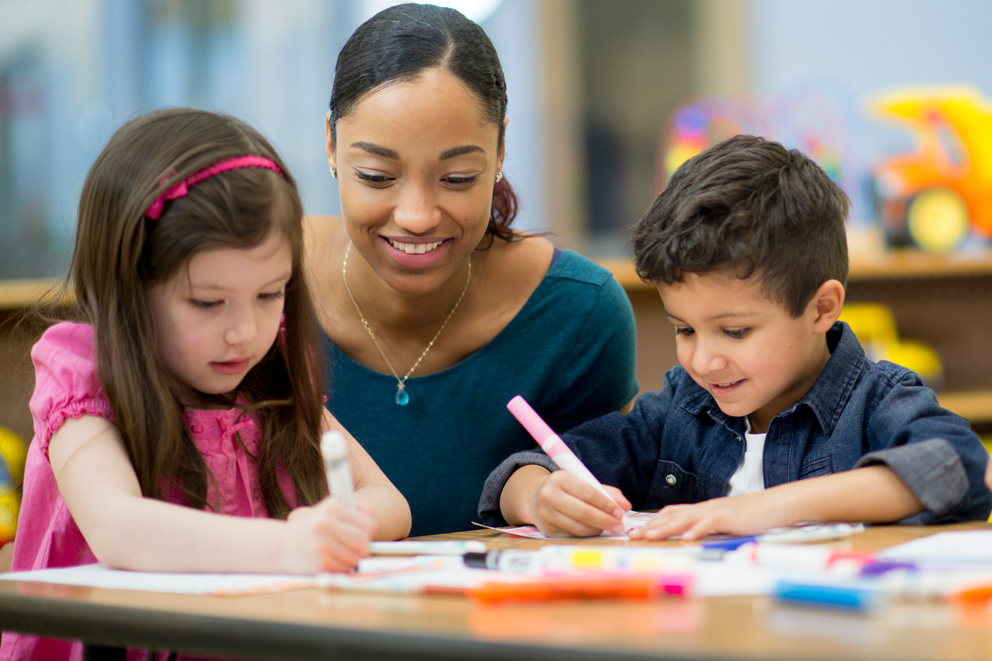Education
Making the Kindergarten Teacher a Friend and not an Enemy

One of the most natural reactions your child may have to meeting the kindergarten teacher on that first day at school is to be intimidated and afraid. The first day of school is a confusing and frightening experience sometimes if your little one has not been out in structured public situations before. The teacher will have a million things to think about and the top of the list will be to teach the children to learn the rules and the structure of school. And while there will be many days and weeks ahead for your child to get used to school, its possible it all could be very overwhelming and your baby may run home in tears that “the teacher hates me”.
Of course you know that the teacher wants only the best for your child. With time, the teacher will have time to spend with each child and that natural bond will occur. But if the first impression your baby boy or girl gets is that the teacher is their enemy and someone to fear, that bond may be slow in coming.
And if the new student gets the feeling that school is a scary place where they are in danger, it could be the beginning of a lot of trouble with school down the road.

So teaching your child that the teacher is not an enemy is very important to her success on the first day of school and your child’s success in school for years to come as well. The first step in helping your child understand that the teacher is a friend is just to talk about it. Sitting with your child and visualizing together how that first day at school will be and seeing the teacher as a protector, a guide and a friend will send the child off to school with a good opinion of the teacher even before the class is called to order for the first time.
It might be helpful to work with your child to understand the relationship between authority and benevolence. You should work to help your child see that even though the teacher is setting the rules and enforcing discipline in the class, she is still the best friend and protector of the children as well. The best example your little one has of this model is, of course, mom and dad. A child has utmost trust and love for her parents. And yet she knows that it is also mom and dad who set and enforce the rules and even punish when the kids have been bad.
By seeing that the role of rules maker and enforcer can be part of being a caregiver, the child can transfer the affection they have for mom and dad to the teacher and understand that role in class.

You can even take the next step in helping your child accept the role of teacher in her life by looking for a chance to go to the school and even sit in on a class just to watch what happens at school. Many schools are happy to let kindergartners that will be starting next year sit in for a day, especially if they are with mom or dad to help them feel secure. You will see some wide eyes as your child absorbs all that goes on in kindergarten. Then you can use that experience to answer a lot of questions when you get home. All of that is outstanding preparation for what the child will experience eon their first day in school.
By meeting the teacher, watching what happens in school and getting familiar with the “idea” of kindergarten, you are getting out ahead of the problem of fear and intimidation that is often big problem for children in their first day at school. The teacher your child will have in the fall will be thrilled to meet her and begin making friends with your child right away. And that short time together may be all it takes to change that teacher from an enemy to a trusted friend and a face your child will look for as soon as she goes to kindergarten that first week. And when your child sails through that first week at school, it will because you took the time to get her ready to have a great time in her first experience at school.
Children
How Can an Educational Consultant Help You

Planning for college can be one of the most stressful times in both a students and parent’s life. Every year the admission standards for most colleges get tougher and getting into the school you want can be a challenge. You’ll need a good transcript from your primary education as well as a great score on college entrance exams. You also need to decide what college’s best fit your educational and career goals before you apply. Having an educational consultant help you with this preparation can make all the difference. A good educational consultant will help you prepare for college in several ways and will also help you pick a group of schools that perfectly match your higher-education needs.
Tutoring for Success

There are several aspects to consider when preparing for a students college experience. Some of these activities start early in their educational journey and others happen when they are older and about to graduate high school. These activities tend to fall into the two main categories of education and preparation.
The educational needs of a child might involve tutoring to make sure they are absorbing important material in class and getting the best grades possible to maintain a high GPA that is needed to give them the widest choice possible for college. This tutoring could be on a specific subject, or even a specific topic within a subject. Tutors will spend time with your child and assess what their needs are and create a program to fit. Some children attend regular tutoring sessions even when their grades are good to make sure they stay ahead of new concepts and material. Tutoring can also improve a child’s test taking abilities. For example a good example of Florida tutoring is done at the Florida Bright Futures center. Before they start any program they will give the student an assessment to discover the areas the student needs help mastering. Once this is done, they then structure an individual program around each students needs. This schedule will also include a few sessions on how to prepare for and take a test.
Taking an exam can be a stressful thing and not every student that understands a subject does well on exams. There are many reasons for this, but knowing how to prepare for an exam as well as techniques for improving the way a child takes the exam can be very valuable. A tutor can help with this and will actually develop a study process for the student that may involve developing study guides and individual study techniques that the student can use to prepare for an exam.
Another thing that a professional educational counselor will help with is college selection and application preparation. They will help you and your student select schools that will fit your needs concerning location, tuition, educational focus and any special interests the student might have. Once you have compiled this list, they will help you prepare the applications for these schools and assist the student present themselves in the best possible light on the application and in person for the interview. This step of preparation is essential in giving the colleges the right impression and can often times make the difference in being accepted.
There is also a wide range of entrance exams needed for college acceptance and getting a good grade on these exams assures you the widest choice of schools. These tests are very specific and cover a range of topics. Having help in preparing for these exams can make a big difference in the resulting grades and by extension gives the student a bigger choice of possible colleges. Having an educational counselor working with the student to prepare for these exams is critical and can take a lot of the stress out of the process. Also, there are certain study techniques that can help with these exams and knowing how to prepare will help the student as well. This might include a few classes to help prepare as and may include practice testing to give the students a flavor of the type of questions that will be on the actual exam like the FCAT.

Many students need to take these exams several times to obtain the required score and an educational counselor will help with keeping track of these scores and may even schedule subsequent exams.
Another way for students to stay ahead of their studies is to attend a specialized summer camp. There are many camps that are organized around improving a certain skill set for school and these can be a lot of fun for the students. They are usually for a weeklong session and allow the students to enjoy camping out with friends and catching up on their studies. Because they are exposed to intense studying techniques and games, students tend to retain more information than they would in a more traditional classroom. These sessions can even be tailored to accommodate a specific subject or range of subjects for a particular grade.
Learning centers are also great places to help a child who has some emotional maturity issues. These centers can develop a program of counseling that will better equip the student to handle any social issues they encounter and help them to cope with the stress of education.
When looking for an educational consultant, be sure to do some research. You want to select a company that has years of experience on their staff and also taught in a real school setting. Also ask about their previous experience in helping students with placement. See if the schools you are considering for your child are on their list of schools that they have helped place a student. Be sure to see what type of tutoring programs they offer and if they have specific programs for SAT and FCAT preparation. Ask them if the tutoring is done as part of a group, or is more individual.
Getting the answers to these questions will help you select the perfect facility for your child’s needs. Finding the extra help you need with tutoring can make a big difference in your student’s grades and attitude towards school. They will be better prepared for their studies and have less pressure of falling behind. Developing the skills to study more effectively will help them for years to come. Having an educational counselor work with the student to assess their skills and develop a program for helping them reach their goals will ensure their success in college and beyond.
Children
Preparing A Special Work Area

Everyone needs a workspace—even kids, or actually, especially kids and a Child Table and Chair Set is the perfect workspace. They need a place where they can draw, write, paint, complete puzzles and crafts, answer an activity book. This is their work, because it’s only through play that they can learn.
That’s why a child table and chair set is as important in a nursery as a crib or a clothes drawer. While children aren’t fussy—they’ll play anywhere, and probably will—their posture and comfort suffer whenever they use a table that’s too big for them. Their shoulders hunch up, their arms stretch just to reach the surface, their legs dangle uncomfortably on the chair (or they’re forced to squat on the chair to compensate for the height). This isn’t helping their concentration, and can actually lead to back pain. Worst of all, they may lose interest in the activity and go do something else—like watch TV—and miss the opportunity to develop their creativity, attention span, and other important skills.
Choosing a Child Table and Chair Set

There are many factors in choosing a child table and chair set for your kids. Review these items to identify your needs and preferences—don’t worry, you’re bound to find a set that’s perfect for your family.
Size. How old are your kids? How tall should the chair be, and how wide a surface do they need? Their feet should be able to reach the floor, and they should be able to rest their arms on the table without hunching their shoulders.
Stability. Chairs shouldn’t wobble, and tables should be able to take the weight of the child leaning on it without toppling over. Also look at the legs of the child table and chairs. Are they securely fastened?
Surface. Have the child tables and chairs been sanded down? You don’t want any splinters or rough spots that can scratch the child. Has the wood been protected with a good varnish? Children will spill water and food on the table, so you want something that can take the wear and tear, and can easily be wiped clean. Also make sure the tables and chairs use a lead-free paint.
Design. What kind of design would fit the motif of your child’s room and personality? Also ask yourself if you want any special features. For example, art tables should have a bar where you can attach those long rolls of paper, making drawing and painting easier and neater. Others have shelves for art materials, tools, or books.
Location. Do you want to keep the child table and chair set in the child’s bedroom or outdoors? And how much space do you have in that corner? Those who have limited space will probably want a more compact child table; others would like a larger child table where the child can take snacks while playing in the yard.
Number. Get child table and chair sets that have more than one chair, perfect for play dates. You should also look for a table with a wide surface, so your child has plenty of room for art equipment and materials, or pieces of a big puzzle.
Designs
There’s a plethora of designs for child table and chairs—all so adorable it can be difficult to pick which one you like best!
Colorful motifs. A little athlete would love a sports motif child table and chair, where the backrests of the chairs are painted to look like different kinds of balls. Wee adventurers would love child table and chairs designed to look like planes, cars and other modes of transportation. Animal lovers will adore jungle-themed, Noah’s Ark or farm-themed child table and chair sets, while your budding dancer will “leap” at the sight of something with a ballerina motif. Does he dream of being a scientist? He’ll absolutely love the cute bug theme (microscope not included). Firemen will like having tables and chairs designed to look like fire hydrants (and red is such an easy color to keep clean, too).
Classic wood. If you prefer a rustic country look, there are many child table and chair sets that are painted in simple white or pastel colors, or retain the wood’s natural finish. These child table and chair sets blend beautifully with all furnishings, and can be kept in the living room without clashing with the “adult” furniture. They also look gorgeous in a Victorian nursery, and can be used for years—regardless of how many times you redecorate your child’s room.
Bright basics. You can also opt for basic primary colors, still “classic” but in the crayon shades that appeal to young children. The advantage of these colors is that they are quite easy to match, and add a touch of life and vibrancy to any room.
Coordinate with other furniture

Children really need child table and chairs for their drawing and writing activities, but don’t stop there—you can buy other accessories in a similar theme or color for a fully furnished nursery.
For example, you can get a children’s ottoman chair where he can put his feet up while he reads a book or watches a favorite video. Unlike the chairs for a worktable, these ottomans are designed to let your child relax, possibly to settle down for a nap.
Bookcases are also important to store children’s reading materials, while toy chest store his treasures (and keep them off the floor, where someone can step on them, or worse, slip on them). If you get themed table and chair sets, you should get furnishings that match the motif or color scheme.
Guidelines and tips
Let your child pick the table and chair set after you’ve narrowed down the choices. Too many choices will overwhelm the child, but do let him have the “final say” about which child table and chair set he’d like to own.
Your child should be responsible for maintaining his work area. Teach him to put away art materials and puzzle pieces, and let him wipe off spills or stains.
Remind your child about safety rules. He shouldn’t stand on the table or jump off it, or climb on the child table and chair (they were not designed to be used as stepladders).
Children
Can We Provide First Grade Reading Help For a Child With Learning Disabilities

First grade reading help is not easily available in a lot of places around the globe for a child with learning disabilities. In the minds of some, a child with learning disabilities is very often not even identifiable before grade two, when they begin to exhibit behavior trouble or fall behind their peers in reading, writing and spelling.
Nevertheless, all experts agree that if we can distinguish the problems early enough, first grade reading help could make a enormous difference in the upcoming schooling of a child with learning disabilities.

The problem maybe lies in the early recognition of a child with learning disabilities. Rather than a definitive test, we find that we have a series of broad, and often highly contentious tests, and we need to postpone a definitive diagnosis until we have complete proof of a learning issue based on the reality that the child is underperforming when compared to their classmates. If detected early enough, first grade reading help may kick start the development process, and this could be exactly what the child with learning disabilities needs to move ahead in their studies.
Teachers clearly are in the front line of this recognition, and they may hold the key to supplying first grade reading help that influences an entire generation. As an Optometrist who has worked with numerous a child with learning disabilities, I imagine that, principally in the early stages of development such as in the first grade, reading help can be offered in functional and simple ways that a child of this age group can understand.
Yet providing first grade reading help for children is not the genuine issue. There are things that can be prepared for children who are struggling. Detecting exactly which child needs the help is the chief task facing teachers and educators, before they become just another child with learning disabilities in subsequent grades, struggling to read, write and spell. It appears that for children in the first grade, reading help is not so much unavailable but beside the point until the presenting trouble become great enough to be apparent and clearly unmistakable to all.
Vision therapy could be a potential form of first grade reading help which is inexpensive, effective and can be applied to most children in the grade without fear of adverse effects. The principle is straightforward: a child with learning disabilities almost always shows decreased visual skills, such as eye movements, focus, directional concepts, visual memory, coding, sequencing and the like.

This lack in visual skills can be considerably improved using simple, simple to know tips that you can do in your own home, without trips to the Optometrist. All you require is access to the right program, and the discipline to employ it. For more information concerning these programs visit our website.
I firmly imagine that the right vision therapy can have a great big influence on how your child develops all through school, and that first grade reading help in the form of vision therapy should be made available to every suspected child with learning disabilities, whether the problems are being manifested in the first grade or not. You have zero to lose, so much to potentially gain and the tips are fun and helpful even if a child appears to be doing satisfactory in class. Don’t make the mistake of waiting too long before you offer first grade reading help for your child.
Darin Browne is a Behavioral Optometrist who lives in Queensland, Australia. He has recently developed an amazing Home Based Vision Therapy Course, which offers over 180 pages of teaching and exercises, empowering parents to train their own childrens visual skills and see positive, sustainable progress in their reading, writing and spelling.
-

 Children5 years ago
Children5 years agoWhy Private School for Your Child?
-

 Children5 years ago
Children5 years agoEating Healthy with kids
-

 Children5 years ago
Children5 years agoHelping Your Child Pick The Best Extracurricular Activities
-

 Children5 years ago
Children5 years agoWhy are kids picky eaters
-

 Children5 years ago
Children5 years agoHow to Deal With Children During a Divorce
-

 Children4 years ago
Children4 years agoEducational Activities For Young Children In The Kitchen With Parents
-
Parents4 years ago
Dealing With A Crying Child While Driving
-

 Children5 years ago
Children5 years agoPUBG Can Be Fun for Everyone












